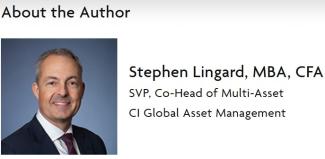
Diversification working on a comeback
After a difficult performance for the 60/40 portfolio in 2022, you might forgive investors for throwing in the towel on the idea of diversification. When stock markets stumbled, where were bonds to mitigate return downside and reduce overall risk? In a few cases, bond markets actually underperformed stock indices. Those investors who reallocated from stocks to bonds to de-risk portfolios suffered mightily. Talk about out of the frying pan, into the fire!
“Does a 60/40 portfolio still make sense?” is the most common question since then, and our message has generally been the same: the champ (diversification) is down but not out. But first, what drove the failure in 2022 as stock and bond price correlation spiked? We suggest it was primarily a function of excessive bond valuations. Negative real yields—that is, nominal bond yields minus inflation—were typical of the quantitative easing period for most central banks, which drove nominal yields through inflation, resulting in a negative real yield to bill and bond investors. This was not a normal state but an emergency monetary policy setting. Financial repression, as it was also called, was done to lure investors from safe cash or low yielding fixed income out the risk curve, and it was successful as an epic stock market rally was unleashed. But as zero policy rates and QE (quantitative easing) gave way to monetary tightening via both higher policy rates and QT (quantitative tightening), grossly overvalued bond markets succumbed to a higher growth/inflation mix supercharged by COVID supply chain snarls and huge government budget deficits that boosted both inflation and growth—kryptonite for nominal bonds.
There is a historical precedent for changing correlations, as the chart below illustrates. In periods of higher inflation (3%+), correlations tend to rise, but as inflation drifts down below 3%, we see better diversification benefits to holding stocks and bonds together. And in fact, we have seen a much-improved diversification environment in recent months as inflation has fallen to 3 %. Regardless of some uncertainty ahead for inflation, diversification remains one of the only free lunches left investing.
Stock–Bond Correlation vs. Core Inflation
Source: Bloomberg Finance L.P., Morningstar Research Inc., as of August 31, 2024. Stocks represented by the S&P 500 Index. Bonds represented by the ICE BofA US Treasury Index. Data measured from December 1980 – August 2024.
Source: Bloomberg Finance L.P., as of October 8, 2024. Stocks represented by the S&P 500 Index. Bonds represented by the iShares 20+ Year Treasury Bond ETF.
And diversification benefits beyond stock–bond correlation, including equity geographic, sector and factor performance, deserve mention here too. U.S. large-cap growth sectors like technology and communication services have been dominant themes in the market in recent years and more recently have been boosted by AI. However, even this has started to change in recent months with some long-suffering areas like international stocks, including emerging markets, value, low volatility factor and defensive sectors like utilities, staples and even real estate, outperforming recently. This was helped by the bond rally since the summer as the market anticipated Fed rate cuts, which finally occurred in September with a somewhat unexpected 50 bp jumbo rate cut. The clear Fed pivot to easier policy pushed the USD lower, breathing additional life into this nascent equity rotation. From a regional perspective, China appears to have finally relented and stepped up policy easing—both monetary and fiscal—unlocking low valuations and excessively negative investor sentiment to propel this market to bounce in recent months.
Equity Region (Trailing Returns) | 3M | YTD |
|---|---|---|
Developed Markets | 4.8% | 19.2% |
United States | 5.9% | 22.1% |
Canada | 10.5% | 17.2% |
United Kingdom | 1.8% | 9.9% |
Japan | -3.5% | 15.2% |
Australia | 7.8% | 12.3% |
Eurozone | 3.1% | 12.4% |
Emerging Markets | 6.8% | 18.7% |
China | 17.9% | 20.3% |
India | 7.0% | 17.9% |
Taiwan | -1.7% | 34.7% |
Source: Morningstar Research Inc., as of September 30, 2024 | ||
Equity Sector (Trailing Returns) | 3M | YTD |
|---|---|---|
Cyclicals | ||
Info. Tech. | 0.9% | 27.3% |
Comm. Services | 1.9% | 25.8% |
Energy | -3.6% | 6.1% |
Materials | 7.7% | 10.4% |
Cons. Disc. | 5.2% | 12.1% |
Financials | 8.6% | 22.1% |
Industrials | 7.6% | 18.7% |
Defensives | ||
Utilities | 16.0% | 23.3% |
Health Care | 4.0% | 14.2% |
Cons. Staples | 7.1% | 13.2% |
Real Estate | 15.5% | 13.2% |
Source: Morningstar Research Inc., as of September 30, 2024. All returns in local currency. The MSCI World sector indices were used. | ||
Equity Factor (Trailing Returns) | 3M | YTD |
|---|---|---|
Momentum | 0.6% | 30.6% |
Quality | 2.5% | 22.5% |
Growth | 1.9% | 21.4% |
Value | 7.9% | 16.8% |
Risk Weighted | 7.1% | 13.4% |
Equal Weighted | 6.5% | 13.3% |
Source: Morningstar Research Inc., as of September 30, 2024. All returns in local currency. The MSCI World factor indices were used. | ||
So, where do we go from here? Bonds have rallied a lot this summer, but at least real yields are still positive with core inflation running ~3% and the entire yield curve above this, so bond valuations are not excessive as pre-2022. Inflation, which is the key variable in the correlation question, is at a critical threshold. If we sail towards the Fed’s target of 2%, we might reasonably expect the benefits of diversification to hold, but there is a very real possibility that inflation gets stuck at 3%, making the Fed’s job tougher as it has already pivoted to focus on the weakening labour market, effectively signaling the inflation genie was back in the bottle. That may be, but inflation improvements are well advanced, while a host of potential inflation boosters are lining up to stall further progress. The details are beyond the scope of this piece, but the list includes higher wages pushing up service inflation (the largest sector of the U.S. economy), trade wars moving us away from global trade and comparative advantage and increasingly volatile weather disrupting food supply, thus pushing up prices, to name a few.
Glossary of Terms
Correlation: A statistical measure of how two securities move in relation to one another. Positive correlation indicates similar movements, up or down, while negative correlation indicates opposite movements (when one rises, the other falls).
Volatility: Measures how much the price of a security, derivative, or index fluctuates. The most commonly used measure of volatility when it comes to investment funds is standard deviation.
Yield Curve: A line that plots the interest rates of bonds having equal credit quality but differing maturity dates. A normal or steep yield curve indicates that long-term interest rates are higher than short-term interest rates. A flat yield curve indicates that short-term rates are in line with long-term rates, whereas an inverted yield curve indicates that short-term rates are higher than long-term rates.
IMPORTANT DISCLAIMERS
The opinions expressed in the communication are solely those of the author(s) and are not to be used or construed as investment advice or as an endorsement or recommendation of any entity or security discussed. This document is provided as a general source of information and should not be considered personal, legal, accounting, tax or investment advice, or construed as an endorsement or recommendation of any entity or security discussed. Every effort has been made to ensure that the material contained in this document is accurate at the time of publication. Market conditions may change which may impact the information contained in this document. All charts and illustrations in this document are for illustrative purposes only. They are not intended to predict or project investment results. Individuals should seek the advice of professionals, as appropriate, regarding any particular investment. Investors should consult their professional advisors prior to implementing any changes to their investment strategies.
Certain statements in this document are forward-looking. Forward-looking statements (“FLS”) are statements that are predictive in nature, depend upon or refer to future events or conditions, or that include words such as “may,” “will,” “should,” “could,” “expect,” “anticipate,” “intend,” “plan,” “believe,” or “estimate,” or other similar expressions. Statements that look forward in time or include anything other than historical information are subject to risks and uncertainties, and actual results, actions or events could differ materially from those set forth in the FLS. FLS are not guarantees of future performance and are by their nature based on numerous assumptions. Although the FLS contained herein are based upon what CI Global Asset Management and the portfolio manager believe to be reasonable assumptions, neither CI Global Asset Management nor the portfolio manager can assure that actual results will be consistent with these FLS. The reader is cautioned to consider the FLS carefully and not to place undue reliance on FLS. Unless required by applicable law, it is not undertaken, and specifically disclaimed that there is any intention or obligation to update or revise FLS, whether as a result of new information, future events or otherwise.
Certain names, words, titles, phrases, logos, icons, graphics, or designs in this document may constitute trade names, registered or unregistered trademarks or service marks of CI Investments Inc., its subsidiaries, or affiliates, used with permission. All other marks are the property of their respective owners and are used with permission. © 2024 Morningstar Research Inc. All Rights Reserved. The information contained herein: (1) is proprietary to Morningstar and/or its content providers; (2) may not be copied or distributed; and (3) is not warranted to be accurate, complete, or timely. Neither Morningstar nor its content providers are responsible for any damages or losses arising from any use of this information. Past performance is no guarantee of future results.
Certain statements contained in this communication are based in whole or in part on information provided by third parties and CI Global Asset Management has taken reasonable steps to ensure their accuracy. Market conditions may change which may impact the information contained in this document.





